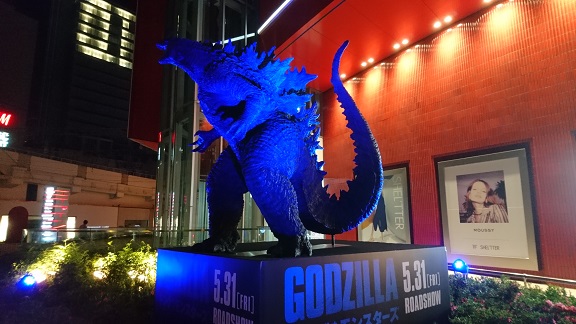
Godzilla Minus One 75/100
November 3rd, 2023 Watched at Movix Amagasaki
Casts: Ryunosuke Kamiki Minami Hamabe
Director: Takashi Yamazaki
Director Takashi Yamazaki, who angered many movie fans with ‘Dragon Quest: Your Story’ somewhat redeemed himself with ‘Lupin the 3rd: The First.’ I bought a ticket a little concerned, but I got my money’s worth/

Introduction
As the end of the war drew near, pilot Shikishima (Ryunosuke Kamiki), assighned the mission of launching a kamikaze attack on the enemy, had to make an emergency landing on Odo-shima Island due to aircraft trouble. However, that night, Godzilla attacked the island, and the detachment was wiped out. The only survivors were Shikishima and the chief mechanic. Later, when Shikishima returned to Tokyo, he learned of his parents’ death. However, he got into a strange relationship with Noriko (Minami Hamabe), and a child to whom she was not the biological mother …

Some major spoilers ahead. You’ve been warned.
Positives
The story began with Odo-shima Island, which put a smile on my face. And Godzilla’s appearance within the first 5 minutes also put a smile on my face. “Shin Godzilla”, the last Japanese Godilla film, had an early appearance of Godzilla, too, but this film immediately shows us the full body of Godzilla, which Shin Godzilla didn’t do.
Once Godzilla got his feet dry, Tokyo turned into a wasteland just like that. Unlike the first Godzilla that was in black and white, this one felt very realistic. In the first film, where all the characters (except Dr. Yamane) were full of sadness and despair. On the other hand, in this film, various characters’ emotions crisscrossed. Despite being a special kamikaze attack team member, Shikishima, the protagonist played by Ryunosuke Kamiki, refused to die and survived. A young girl who some other woman entrusted her baby to somehow got to know him. The next door widow, played by Sakura Andoh, intervened and helped this young strange couple. Even though the story was set in 1945, it was still very easy to sympathize with these characters because the emotions they were going through were universal.
Godzilla, powered up and enlarged by the Bikini Atoll nuclear tests, soon reappeared and destroyed the heck out of the Ginza district, which was a direct homage to the original. I couldn’t help but raising my fist into the air at the appearance of the tank unit because that was what happened in the original movie. Godzilla’s atomic breath was, in a sense, more destructive than Shin Godzilla’s. The rising mushroom cloud evoked memories of GMK (my favorite Godzilla movie!). What an overwhelming sense of despair and loss!
“Shin Godzilla” was about a national effort to stave off and terminate Godzilla, but this film was about a civilian operation against Godzilla, given the pre-Cold War situation at the time and the fact that Japan had been demilitarized by GHQ. It had only been a few years since the end of the war, so there were still quite a few military survivors. When they revealed the tactic, a gadget appeared and it immediately put a smile on your face because it reminded us of the Oxygen Destroyer from the original. The operation involved targeting Godzilla’s weakness as a living creature, and it was reasonably and logically convincing because that was basically what Mechagodzilla from “Godzilla vs. Kong,” tried to do to Godzilla. The Godzilla theme that played as warships surrounded Godzilla just before this attack was truly an homage to the original because in the first movie, this music came on not when Godzilla destroyed Tokyo, but when the tank unit arrived and opened fire against Godzilla. That unique Akira Ifukube’s Godzilla theme song was originally the BGM when the Self-Defense Forces appeared. In this film, it was used as the theme song for civilian forces, not for Godzilla. Finally, there’s a kamikaze attack on Godzilla’s mouth, just like the anti-nuclear bacteria missile in “Godzilla vs. Mothra.” A heavily wounded Godzilla sinking to the bottom of the ocean was clearly an homage to GMK, which again did put a smile on my face.
Writer/director Takashi Yamazaki successfully made a name for himself for creating a new Godilla movie out of the traditional Godzilla movies.

Negatives
The human drama part was weak. To be more precise, it was hard to see the focus of the dramas. It wasn’t clear whether the film wanted to focus on the process of Shikishima, Noriko, and Akiko turning from a pseudo-family into an authentic one or if it wanted to focus on Shikishima and the other survivors overcoming their war traumas. It should have concentrated on on big subplot, not two.
A few of the actors’ performances stood out like a sore thumb. Shikishima, the main character, was completely overshadowed by Yoshioka Hidetaka and Kuranosuke Sasaki. The acting, or rather the directing, often missed the mark. In the final scene, Shikishima dropped the coat he was wearing onto the ground, but wasn’t the timing a bit off? That kind of scene happened throughout the film. It felt like Shikishima’s acting or the director’s direction didn’t quite fit in with the main character.

Overall Summary
Defining Godzilla is difficult, but it’s easy to recognize what is not Godzilla. In that sense, there is no room for doubt that the creature in this film is Godzilla, and this film is a Godzilla movie. Showa Godzilla was all about Godzilla destroying Japan, yet Japan always underwent a rehab in a booming economy. Reiwa Godzilla, on the other hand, is portrayed as an ominous force that could come back any time if Japan continues to economically dwindle and politically become right wing. The highly able and competent Japanese government depicted in ‘Shin Godzilla’ was fiction. It seems we’ve entered an era where we, as civilians, must make sure that Godzilla is not real and that he belongs in fiction and entertainment.















